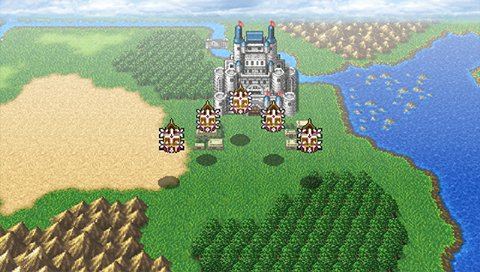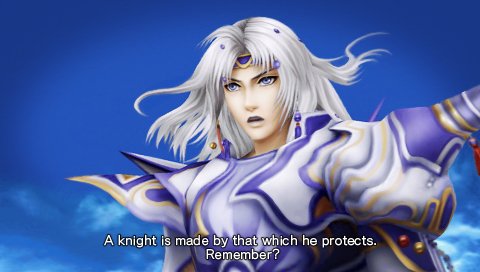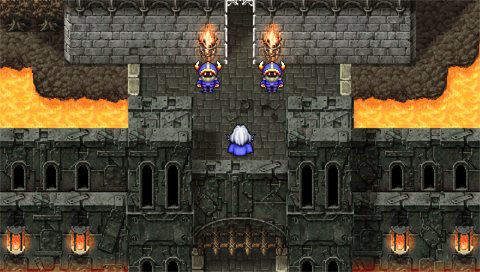Takashi Tokita on the legacy of Final Fantasy IV
Celebrating twenty years of spooniness
GR: But back when FFIV was made on the Super Famicom, it was a totally state-of-the-art machine. Didn’t that new, powerful hardware change the way the team approached development on FFIV? What did you do with the game that you couldn’t have done before?

TT: The biggest thing we were able to use was the Mode 7 features. The first time you saw those airships flying was really exhilarating, wasn’t it? You’d spend lots of time just flying around in that new perspective. *Laughs* We were also able to up the number of party members to five thanks to the increased sprite capacity.
GR: Why is FFIV the only game in the series that has ever had a five-person party?
TT: Actually, I’m not sure why we didn’t keep that after FFIV. I guess I understand for FFV, since we had the whole job system feature… technically, by today’s hardware specs, we could do hundred-person parties if we wanted to, but it’d be far too cumbersome.
Actually, way back in the Famicom era, Tanaka-san (the lead developer of Final Fantasy XI) wanted 10-person parties… but then it wouldn’t have really looked much like an FF game. Imagine a bunch of teeny little sprites surrounding monsters. But Tanaka-san likes little characters, because he’s a big, tall guy… he invented the whole Mini spell in Final Fantasy III, as well. Because he likes little people. *laughs*

GR: Since we’re on the topic of the game content itself now… in FFIV, there was a neat little easter egg in the Dwarf Castle: a hidden programmer’s room where all of the development staff resided and had some choice words about the game’s development. You just don’t see this sort of thing in games anymore. Why do you think that is?
TT: Well, these days, the size of development teams has ballooned considerably. It’s hard to get everybody’s comment on the game like that. There’s also a general feeling these days that including that sort of thing is “kakkowarui” – it’s not cool. Of course, I certainly don’t think it’s uncool, so I try to put it in – in fact, we got three rooms in this edition, one for each separate game. I make an appearance in each one, too: At first, I’m about to die. Then, in the next room, I’m a skeleton, and finally, I’m a ghost. *laughs* Enjoy the difference!
Weekly digests, tales from the communities you love, and more
GR: So we’ve got a new Dissidia coming out soon, and we’ve got both Kain and Cecil in that game. What do you think of their Dissidia interpretations?
TT: Well, the characters had never been rendered in that sort of “realistic” fashion outside of FMV before Dissidia came along. I don’t care so much about all the extra details, but it’s great that they respect the characters. They even got the same voice actors from the DS version. For people who play Dissidia but haven’t played FFIV, it’s a glimpse into the game and its characters, and I hope it would entice them to come back and try out the original game, and thus expand our customer base.

Above: Paladin Cecil as he appears in Dissidia
GR: What are the challenges involved in keeping fans satisfied when doing these remakes and story augmentations?
TT: Well, I think that for this version in particular, putting all three parts of the story – the original game, Interlude, and The After Years – in a single package makes everything more coherent and appealing to buyers. But we’ve made a lot of concessions to “old-school” players as well – you can change the music back to the original Super Famicom score, you’ve got the old illustrations… everything we’ve packed in here goes beyond just the games themselves. It’s really made to celebrate this title’s 20th anniversary.
GR: So in this version, will things like the extra scenarios from the GBA edition be available, or are you looking to keep as faithful to the source material as possible?
TT: No, the GBA dungeons aren’t in this edition, but fans might notice a few additions to The After Years…
GR: Ooh, nice!
TT: Taking into account your previous question… out of all the things we’ve done in the past with the remakes, the thing that actually caused the most controversy was the addition of voice acting in the DS version. People have their own image of how these characters sound, so when actual voices are attached, they either like it or don’t like it. The voices in the Japanese version of FFIV on DS are a reflection of the image I personally had of the characters, but I guess they weren’t the same for everyone.

GR: Indeed, it’s always tough to realize in audio what many have imagined in their mind through text for such a long time. Tokita-san, thank you for your time – it was wonderful talking to you!
TT: Thank you!
Mar 8, 2011


